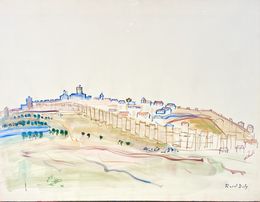


Henriette
Raoul Dufy
Fine Art Drawings - 50.5 x 46 x 0.1 cm Fine Art Drawings - 19.9 x 18.1 x 0 inch
$1,740


Les Remparts
Raoul Dufy
Painting - 50 x 65 x 1 cm Painting - 19.7 x 25.6 x 0.4 inch
Price upon request
My eyes are greedy to see, voraciously greedy, with an intensity that I am conscious of.
Biography
The well-known artist, Raoul Dufy, was born in Le Havre, in 1877. A painter, draftsman, printmaker, illustrator, ceramic artist and set designer, he stands out thanks to his unique approach to colours and contours. He studied at the Le Havre Municipal School of Fine Arts with Charles L'Huillier, and then at the 'Beaux Arts de Paris' (Paris School of Fine Arts) in 1900.
The portrayal of landscapes plays a prominent role in his artwork. He first produced watercolour paintings of Normandy landscapes, followed by the beach at Sainte-Adresse, which had also inspired the Impressionists, such as Monet and Boudin, and he later portrayed the Martigues canals in Provence. The painter went on to travel extensively across Europe, and paid particular visits to Italy, where he loved to marvel at the works of Titian. As early as 1901, he displayed his artwork at the 'Salon des Artistes Français' (French Exhibition of Artists), and then at the 'Salon des Indépendants' (Exhibition of Private Artists). At the time, he was friends with Raimond Lecourt and Othon Friesz, and he would go on to work extensively with them, inspired by Henri Matisse and the Fauvism movement. He also worked closely with Artigas on ceramic art. Around this period, he started to depict cheerful family outings to the horse races.
It was in 1907 that Raoul Dufy recognised the prominence of Cézanne, and gradually moved away from Fauvism. At the 'Villa Médicis Libre' residence, where he stayed with André Lhote and Jean Marchand, he was inspired by Cubist artists such as George Braque and Pablo Picasso. Profoundly focused on patterns, he worked with Paul Poiret to design print patterns for fabric. His artwork developed over time - it adopted a softer style, and featured increasingly bright colours. In fact, whilst catching a glimpse of a little girl running along the Honfleur quay, he discovered that colour is the first thing recalled in our mind's eye. Thus, he started to use washes of paint, and would then draw on additional detail to define the subject, using a curved, elegant line. He moved towards a sense of colour consistency, and tended to prefer certain warm tones in his canvases.
The artist died in 1953, but leaves behind over two thousand paintings, including the world's largest painting: 'La Fée Électricité' (The Spirit of Electricity), 624m2 in size, displayed in the 'Musée d'Art Moderne' (Museum of Modern Art) in Paris. His work is also exhibited at the 'Musée Marmottan' (Marmottan Museum).
Nationality
Categories
Artistic movements
Themes


